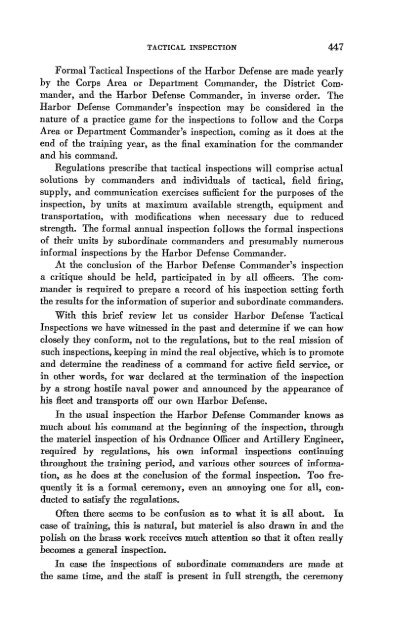COAST. I ARTILLERY JOURNAL, - Air Defense Artillery
COAST. I ARTILLERY JOURNAL, - Air Defense Artillery
COAST. I ARTILLERY JOURNAL, - Air Defense Artillery
Create successful ePaper yourself
Turn your PDF publications into a flip-book with our unique Google optimized e-Paper software.
TACTICAL INSPECTION 447<br />
Formal Tactical Inspections of the Harbor <strong>Defense</strong> are made yearly<br />
by the Corps Area or Department Commander, the District Commander,<br />
and the Harbor <strong>Defense</strong> Commander, in inverse order. The<br />
Harbor <strong>Defense</strong> Commander's inspection may be considered in the<br />
nature of a practice game for the inspections to follow and the Corps<br />
Area or Department Commander's inspection, coming as it does at the<br />
end of the traiping year, as the final examination for the commander<br />
and his command.<br />
Regulations prescribe that tactical inspections will comprise actual<br />
solutions by commanders and individuals of tactical, field firing,<br />
supply, and communication exercises sufficient for the purposes of the<br />
inspection, by units at maximum available strength, equipment and<br />
transportation, with modifications when necessary due to reduced<br />
strength. The formal annual inspection follows the formal inspections<br />
of their units by subordinate commanders and presumably numerous<br />
informal inspections by the Harbor <strong>Defense</strong> Commander.<br />
At the conclusion of the Harbor <strong>Defense</strong> Commander's inspection<br />
a critique should be held, participated in by all officers. The commander<br />
is required to prepare a record of his inspection setting forth<br />
the results for the information of superior and subordinate commanders.<br />
With this brief review let us consider Harbor <strong>Defense</strong> Tactical<br />
Inspections we have witnessed in the past and determine if we can how<br />
closely they conform, not to the regulations, but to the real mission of<br />
such inspections, keeping in mind the real objective, which is to promote<br />
and determine the readiness of a command for active field service, or<br />
in other words, for war declared at the termination of the inspection<br />
by a strong hostile naval power and announced by the appearance of<br />
his fleet and transports off our own Harbor <strong>Defense</strong>.<br />
In the usual inspection the Harbor <strong>Defense</strong> Commander knows as<br />
much about his command at the beginning of the inspection, through<br />
the materiel inspection of his Ordnance Officerand <strong>Artillery</strong> Engineer,<br />
required by regulations, his own informal inspections continuing<br />
throughout the training period, and various other sources of information,<br />
as he does at the conclusion of the formal inspection. Too frequently<br />
it is a formal ceremony, even an annoying one for all, conducted<br />
to satisfy the regulations.<br />
Often there seems to be confusion as to what it is all about. In<br />
case of training, this is natural, but materiel is also drawn in and the<br />
polish on the brass work receives much attention so that it often really<br />
becomes a general inspection.<br />
In case the inspections of subordinate commanders are made at<br />
the same time, and the staff is present in full strength, the ceremony
















